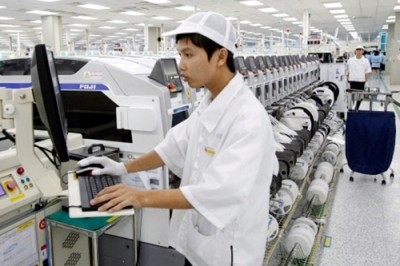Increase in FDI volume and changes in quality
“We choose Vietnam as an investment destination due to its strongly increasing demand, stability and attractive advantages”, said Yeon-Joo Jung, Vice Chairman and CEO of Samsung C&T Corporation. Since early this year, Samsung has been licensed to invest in a series of large-scale FDI projects in Vietnam, including the US$2 billion Samsung Electronics Vietnam project and the US$1.23 billion Samsung Electro-Mechanics project in Thai Nguyen province, as well as the Samsung Electronics Vietnam project in Bac Ninh province, which increased its registered investment from US$1.5 billion to US$2.5 billion.
In addition to Samsung's investments, many other projects were licensed with investment capital ranging from US$1 billion to US$2.8 billion. The Ministry of Planning and Investment announced that the total amount of newly registered and additional FDI capital in the first ten months of this year was US$19.2 billion, an increase of 65.5% over the same period last year. Of the total, US$13 billion went to newly registered projects and US$6.1 billion was expanded capital.
Economist Le Dinh An said that FDI attraction has seen a certain refinement that concentrates on transnational corporations such as LG and Samsung or traditional partners of Vietnam such as Japan, the Republic of Korea (RoK), Singapore and Russia. Moreover, FDI inflow mainly goes to manufacturing and processing industries (accounting for 77.6% of total registered capital), which falls in line with the country’s FDI attraction orientation.
According to Professor Nguyen Mai, Chairman of the Vietnam Association of Foreign Invested Enterprises, that a large percentage of FDI is poured into manufacturing and processing demonstrates the improved quality of FDI inflow into Vietnam.
Despite global economic difficulties, Vietnam saw a 65.5% year-on-year increase in FDI pledges in the first ten months of 2013 because the country has met the necessary and sufficient conditions for attracting large-scale FDI projects, such as adequate infrastructure, skilled human resources, sound investment policy and the support of the Government and local authorities, said Doctor Phan Huu Thang, former director of the Foreign Investment Department under the Ministry of Planning and Investment.
Dr Thang noted that FDI projects with capital expansion contribute largely to the total FDI inflow to Vietnam, indicating the optimism of foreign investors about the long-term potential and prospects of the Vietnamese market. Many investors see the need to continue investing and expanding their business in Vietnam to ensure the efficiency of ongoing projects, which will also create a pervasive influence on other investors.
Receiving and screening
According to economic experts, investment in the industrial sector is often long-term and sustainable, as it is associated with creating new facilities, training qualified workers and developing domestic supporting industries.
However, economist Le Dinh An said that a majority of FDI projects in the field are processing and assembly projects which generate little value for the local economy because almost all the machines, raw materials and technology for production are imported and the output is entirely for export.
The main reason for this situation is that Vietnam has not yet established a proper supporting industry for the industrial sector. The agricultural sector also encounters the same problem, as it lacks a supporting industry in the areas of microbiology, genetically modified organism (GMO) technology, seedling and breeding technology. Therefore, supporting industries have been identified as a key sector in which to invest.
For some time, the agricultural sector has accounted for a small proportion of FDI attraction, and has not seen a breakthrough improvement as the sector is considered a mainstay of the economy in such a tough time. Meanwhile, FDI in the service sector has seen a sharp decline and FDI in the real estate market has funded only small-scale projects. Vietnam needs hundreds of billion of US dollars to invest in infrastructure by 2020, but to date there have only been ten FDI projects licensed in the build-operate-transfer (BOT) model.
Currently, Vietnam is on the way to negotiating free trade agreements with other countries, such as theTrans-Pacific Partnership Agreement (TPP) and the Vietnam-EU Free Trade Agreement (FTA), which promise a wave of investment into garments, textiles and footwear. Foreign investors expect to make use of the country's cheap labour and lower export tax rates in markets with which Vietnam will sign free trade agreements.
However, economists warn that caution should be exercised when receiving FDI inflow, otherwise huge opportunities from the TPP will only go to FDI enterprises and domestic enterprises will be overwhelmed. They say that FDI inflow should be attracted based on the advantages of high-quality human resources instead of those of cheap labour.
Over US$19 billion in FDI pledges to Vietnam is not a small figure as the race for FDI attraction between countries becomes increasingly fierce. However, the challenge lies in how to disburse the capital in the shortest possible time.
While assessing the disbursement of FDI, Dr Thang said that whether registered FDI projects are able to be implemented or not depends on many factors. But based on the actual results of FDI projects in the past, 90% of registered FDI capital in the January-October period is likely to be disbursed.
The Government recently issued Resolution No.103/NQ-CP on improving the efficiency of FDI attraction, use and management in the future. The resolution includes a series of tasks and measures that need to be implemented to deal with issues related to FDI projects, such as re-registration of FDI projects, fugitive FDI enterprises, tax fraud, developing supporting industries and FDI attraction paralleled with environmental protection and sustainable development. Another important factor affecting the attraction and performance of FDI is the involvement of relevant ministries, industries and localities in implementing the Government’s resolution on FDI attraction.
















